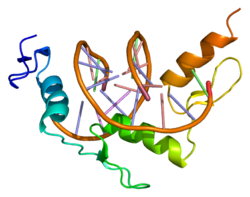Top Qs
Timeline
Chat
Perspective
EGR2
Protein-coding gene in the species Homo sapiens From Wikipedia, the free encyclopedia
Remove ads
Early growth response protein 2 (EGR2), also known as Krox20, is a transcription factor encoded by the EGR2 gene in humans. It is highly expressed in migrating neural crest cells and later in neural crest-derived cells of the cranial ganglia.[5][6][7] Expression of EGR2 is restricted to early hindbrain development,[6][8] and the gene is evolutionarily conserved among vertebrates, including humans, mice, chicks, and zebrafish.[9] The conservation of its amino acid sequence and embryonic expression pattern underscores its essential role in hindbrain segmentation and neural differentiation.[7][10][11][12]
Remove ads
Structure
The EGR2 protein contains three tandem C2H2-type zinc finger domains that mediate specific DNA binding.[6][8] These zinc fingers enable EGR2 to function as a transcriptional regulator of genes involved in neural development and myelination.
Function
EGR2 acts as a transcription factor that regulates gene expression during neural development and peripheral nerve myelination. It binds to specific DNA sequences via its zinc finger motifs to control target genes essential for Schwann cell differentiation and myelin sheath formation.[13] It is also expressed in osteoprogenitor cells and has been implicated in the proliferation of Ewing sarcoma–derived cell lines, suggesting a role in both bone biology and tumorigenesis.[14][15]
Remove ads
Clinical significance
Mutations in EGR2 are associated with several hereditary demyelinating neuropathies, including Charcot–Marie–Tooth disease type 1D,[13] Dejerine–Sottas disease,[16] and congenital hypomyelinating neuropathy.[17] Recent studies have also suggested that EGR2 expression in hair follicle stem cells may influence hair maintenance and pigmentation, with loss of Krox20-expressing cells contributing to male-pattern baldness and graying hair.[18]
Deletion of Egr2 in mice results in loss of protein-coding capacity, including the DNA-binding domain, leading to perinatal lethality and severe hindbrain malformations.[6][8] These defects include aberrant formation of cranial sensory ganglia, fusion of the trigeminal (V), facial (VII), and auditory (VIII) nerves, and disorganization of their proximal roots as they enter the brainstem.[19][20][21]
References
Further reading
External links
Wikiwand - on
Seamless Wikipedia browsing. On steroids.
Remove ads






